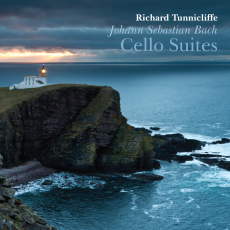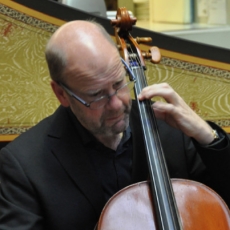Richard Tunnicliffe - J.S. Bach: Cello Suites - SA-CD.net
Performance: Sonics (S/MC):
Sonics (S/MC): /
/
Richard Tunnicliffe
may not be a household name as a cellist, but he has the required
technique, individuality, practical experience and spirit required to
tackle Bach's celebrated Suites for Solo Cello. This is his first solo
album. He is principal cello with The Avison Ensemble, whose
performances and recordings of English string music of the 18th century
are highly prized, and also a gamba player in the renowned viol consort
Fretwork, known worldwide for their innovative programmes, which
frequently include new works.
Apart from this, he is also
principal cello with the Orchestra of the Age of Enlightenment, with
whom he has been associated since its foundation, and has worked as
cellist/gambist with the Boston Symphony, Frankfurt Radio S.O., City of
Birmingham S.O., English National Opera, Scottish Chamber Orchestra and
the London Mozart Players, and under conductors such as Haitink, Rattle,
Iván Fischer, Mackerras and Elder. As an international soloist, his
recitals of the Bach Cello Suites have been widely acclaimed, and like
other cellists he has devoted much-study time to these enigmatic works.
The
Cello Suites remain enigmatic because Bach's autographs are lost, There
are only four early copies, each of them with different slurs, bowings
and phrasing marks, but complicated with obvious mistakes in copying the
notes themselves. Probably the most authoritative is the copy by Anna
Magdelena, Bach's second wife. Fortunately, comparing the real autograph
of the likely near-contemporaneous Sonatas for Solo Violin with AM's
own copy of the violin sonatas, researchers have shown that she added a
number of markings of her own to her copy of the Cello Suites. In his
excellent booklet notes, Tunnicliffe refers to Anna Magdelena's effort
as "sloppy", but hers is the basic version from which he works, as do a
number of other cellists.
The greatest part of Tunnicliffe's
career has been working with period performance practices, but he wisely
does not claim any spurious "authenticity" for the present recording.
Apart from the paucity of performance directions in the scores, there is
no irrefutable evidence of what kind of instrument Bach wrote the
suites for. Sigiswald Kuijken's research has provided possibly
convincing evidence that the cello most likely found at the court of
Cöthen at the probable time of the Cello Suites's composition around
1720 was the 'violoncello da spalla' (from the Italian for "shoulder"),
which was held horizontally at the chest, against or on the right
shoulder. It could easily be played by a violinist.
A smaller
version of this da spalla (or another kind of cello), with 5 strings,
was specified by Bach for Suite no. 6 as a 'violoncello piccolo' (small
cello). Richard Tunnicliffe is one of few cellists who actually uses a
5-string cello (a cello piccolo by Pierre Malahar, Bordeaux 1726) for
the Sixth Suite. Later in the C18th, a cello appeared in Italy which was
"da gamba", i.e. held between the knees, and this only slowly made its
way into the small German courts where Bach worked. Subsequently the
end-pin or spike was added by Servais at the middle of the C19th (he was
too fat to hold the cello between his knees!), and other changes
shortened the neck, so advances in stringing were also needed to give
the modern cello a solo presence when playing concertos with a large
orchestra.
For Bach's Suites 1-5, Tunnicliffe uses a cello
attributed to Leonhard Maussiell, Nuremberg c.1720. This has outstanding
beauty of tone and a particularly sonorous lower region which is very
close to the glorious bass of the long-necked Servais cello residing in
the Smithsonian Collection. No information is supplied by Linn about the
cello's degree of C18th modification, nor the type of strings used
(gut, wire or wire-wound). Both Tunnicliffe's instruments are tuned to A
= 415Hz, a common Baroque pitch, lower than today's standard. There is
little or no evident vibrato, but the resonance of the cello itself is
sufficiently rich and sustained to give a very affecting sound.
Linn
recorded several sessions of the Suites in St George's Church,
Chesterton, Cambridge, UK during2010-2011. Session continuity is
excellent, and the church acoustic lends a warmly resonant bloom to the
cellos, particularly delicious when listened to using 5.1 multichannel
mode. The microphones are close enough to capture a fair amount of nasal
breathing, but rather than this being distracting, I found it added to
the illusion of Tunnicliffe playing in one's enlarged music-room. The
overall cello sound is rich in overtones and particularly gorgeous in
the lower regions; some of the best recorded solo cello sound I have
ever heard - partly due to the inherent qualities of the instrument
itself.
Tunnicliff's performances are simply magnificent. I was
captivated from the very first bars of Suite 1's flowing Prelude, which
exuded a happy-feeling radiant warmth typical of all his playing. As one
so experienced in Baroque music, his technique involves a clear but not
intrusive rhythmic pulse (some famous cellists tend to become so
involved in interpreting the melodic lines of these dances that they
loose the rhythms completely). The other immediately remarkable
characteristic is that his cello sings in a truly vocal way. Bach's
ineffable melodic lines really do sing out in Tunnicliffe's hands, and
they are phrased exquisitely. Such eloquent melodic lines are not always
obvious from the scores, often being tightly bound up with
ornamentation such as arpeggios and scale runs. Tunnicliffe's lucid and
naturally-contoured parsing of the notation frees the melodic lines, and
in so doing makes for much easier listening, compared with "period"
versions by Bylsma, Kuijken and ter Linden, not to mention some other
well-known proponents of the Suites.
Another attractive
characteristic of Tunnicliffe's reading of the Suites is his ability to
decode and present a strong character for each one, without any
over-interpretation or quirky indulgence. As he points out in his notes,
each suite takes its character from its Prelude. Many of the dance
movements also reveal his innate sense of humour, sometimes rustic or
cheeky, sometimes tongue-in-cheek with a pointedly "genteel" style. All
of these nuances contribute to the vivid colouration of his readings.
The
stately Sarabandes unwind movingly as sensuous, lofty, pensive, tragic
or noble discourses, supported by more chords than found elsewhere in
the dances. Tunnicliffe tells us in his notes that the Sarabande of the
Fifth Suite has a winding single melodic line of such intensity that it
recalls for him Bach's "et incarnatus est" from the B minor Mass. His
playing of it is tear-laden. In Suites 4-6 the dance movements become
progressively more abstracted, and this often calls for virtuosity: here
it is never forced and always is at the service of the dance's original
spirit.
Suite 5 has a scordatura, i.e. the top string is
down-tuned from A to G. This notably changes the resonance of the cello,
which develops a gruff bass and a more incisive upper range. This Suite
has the most perfect French set of dances, which respond with good
humour to the changed tonal colours. The 5-string cello also offers a
whole new range of timbres for Tunnicliffe to work with; its lightness
and silvery tone propels fast running textures into shimmering streams,
and he even manages a very good imitation of a droning French
hurdy-gurdy in the famous jaunty Gavotte. All this energetic playing
appears to be effortless, never dragging or labouring.
Every
performance of the Six Suites for Solo Cello is a unique communion of
player with instrument.. There is no "best" performance. Every performer
strives to give a "better" one next, in their own judgement. Pierre
Fournier, for example, recorded them four times, in 1959, 1960, 1972 and
1977. Compare these, and you will find quite remarkable differences.
Taking just the Prelude from Suite No. 1 in C, it is slow and solemn in
1959, but much faster and lighter in 1977. So choosing from a rich list
of recorded performances is difficult for collectors, especially
novices. I suggest that Tunnicliffe's (first!) recording would be a good
choice for anyone wanting to to start their communion with Bach's Cello
Suites. And if, like me, you already have 15 or more versions that you
could not do without, you will need Tunnicliffe's happy, lucid and
seemingly inevitable version too.

